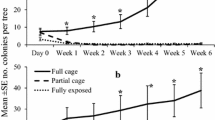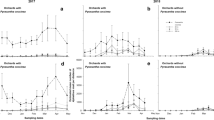Abstract
Studies supporting a project seeking to introduce Heringia calcarata (Loew) (Diptera: Syrphidae) to New Zealand (NZ) to supplement biological control of woolly apple aphid (WAA), Eriosoma lanigerum (Hausmann) (Hemiptera: Aphididae) are reported. Annual surveys of H. calcarata presence and abundance in a Virginia, USA apple orchard revealed a bimodal distribution, with peaks in mid-June and mid-September. In the field, female H. calcarata oviposited on sentinel apple shoots infested with WAA, providing an efficient method for egg collection and larval production. Similarly, most field-collected females readily deposited viable eggs on WAA colonies in laboratory cages, demonstrating that mated females will oviposit in captivity. Survivorship of eggs and larvae transported to NZ was good, yielding adult flies in containment in Auckland. Adult, virgin female H. calcarata reared from eggs in captivity developed mature oocytes, providing an important step toward future mating studies in containment. Oviposition and larval feeding studies examined aspects of the intraguild interactions between H. calcarata and Aphelinus mali (Haldeman) (Hymenoptera: Aphelinidae), the sole biological control agent of WAA in NZ. Field tests using paired sentinel apple shoots with a non-parasitized or parasitized WAA colony revealed that although H. calcarata deposited eggs on both parasitized and non-parasitized colonies, fewest eggs were deposited on heavily parasitized colonies. Feeding studies showed that larval H. calcarata consumed fewer mummified aphids or aphids in an earlier stage of parasitization than non-parasitized aphids.


Similar content being viewed by others
References
Akinlosotu TA (1978) The inter-relationship of the cabbage aphid parasite, Diaeretiella rapae McIntosh (Hym: Aphidiidae) and the entomophagous predators of the aphid. Niger J Entomol 3:5–9
Almohamad R, Verheggen FJ, Francis F, Hance T, Haubruge E (2008) Discrimination of parasitized aphids by a hoverfly predator: effects on larval performance, foraging, and oviposition behavior. Entomol Exp Appl 128:73–80
Asante SK (1997) Natural enemies of the woolly apple aphid, Eriosoma lanigerum (Hausmann) (Hemiptera: Aphididae): a review of the world literature. Plant Prot Quart 12:166–170
Babendreier D, Bigler F, Kuhlmann U (2005) Methods used to assess non-target effects of invertebrate biological control agents of arthropod pests. BioControl 50:821–870
Barlow CA (1961) On the biology and reproductive capacity of Syrphus corollae Fab. (Syrphidae) in the laboratory. Entomol Exp Appl 4:91–100
Belliure B, Michaud JP (2001) Biology and behavior of Pseudodorus clavatus (Diptera: Syrphidae), an important predator of citrus aphids. Ann Entomol Soc Am 94:91–96
Bergh JC, Short BD (2008) Ecological and life-history notes on syrphid predators of woolly apple aphid in Virginia, with emphasis on Heringia calcarata. BioControl 53:773–786
Bodenheimer FS (1947) Studies on the physical ecology of the woolly apple aphis (Eriosoma lanigerum) and its parasite Aphelinus mali in Palestine. Bulletin 43, Rehoboth Agricultural Research Station, Israel
Branquart E, Hemptinne JL (2000) Development of ovaries, allometry of reproductive traits and fecundity of Episyrphus balteatus (Diptera: Syrphidae). Eur J Entomol 97:165–170
Brown MW, Schmitt JJ (1994) Population dynamics of woolly apple aphid (Homoptera: Aphididae) in West Virginia apple orchards. Environ Entomol 23:1182–1188
Chambers R (1988) Syrphidae. In: Minks AK, Harrewijn (eds) World crop pests: Aphids, their biology, natural enemies, and control. Elsevier, Amsterdam, The Netherlands, pp 259–270
Charles J (2012) Assessing the non-target impacts of classical biological control agents: is host-testing always necessary? BioControl 57:619–626
Colfer RG, Rosenheim JA (2001) Predation on immature parasitoids and its impact on aphid suppression. Oecologia 126:292–304
Erbilgin N, Dahlsten DL, Chen PY (2004) Intraguild interactions between generalist predators and an introduced parasitoid of Glycaspis brimblecombei (Homoptera: Psylloidea). Biol Control 31:329–337
Frank DL, Leskey TC, Bergh JC (2010) Development of a rearing methodology for the dogwood borer (Lepidoptera: Sesiidae). Ann Entomol Soc Am 103:50–56
Frazer BD (1972) A simple and efficient method of rearing aphidophagous hoverflies (Diptera: Syrphidae). J Entomol Soc BC 69:23–24
Gontijo LM (2011) Integrated biological control of woolly apple aphid in Washington state. Doctor of Philosophy: Entomology. Washington State University, Pullman, USA
Gontijo LM, Cockfield SD, Beers EH (2012) Natural enemies of woolly apple aphid (Hemiptera: Aphididae) in Washington State. Biol Control 41:1364–1371
Hart AJ, Bale JS (1997) A method of mass-rearing the hoverfly Episyrphus balteatus (Diptera, Syrphidae). Dipter Dig 4:1–3
Jazzar C, Meyhofer R, Ebssa L, Poehling HM (2008) Two protagonists on aphidophagous patches: effects of learning and intraguild predation. Entomol Exp Appl 127:88–99
Kindlmann P, Ruzicka Z (1992) Possible consequences of a specific interaction between predators and parasites of aphids. Ecol Model 61:253–265
Martinou AF, Raymond B, Milonas PG, Wright DJ (2010) Impact of intraguild predation on parasitoid foraging behaviour. Ecol Entomol 35:183–189
Medvey M (1988) On the rearing of Episyrphus balteatus (Deg.) (Diptera: Syrphidae) in the laboratory: Ecology and effectiveness of aphidophaga. In: Niemczyk E, Dixon AFG (eds) Ecology and effectiveness of aphidophaga. SPB Academic Publishing, Teresin, pp 61–63
Meyhofer R, Klug T (2002) Intraguild predation on the aphid parasitoid Lysiphlebus fabarum (Marshall) (Hymenoptera: Aphidiidae): Mortality risks and behavioral decisions made under the threats of predation. Biol Control 25:239–248
Nakazawa T, Yamamura N (2006) Community structure and stability analysis for intraguild interactions among host, parasitoid, and predator. Popul Ecol 48:139–149
Nicholas AH, Spooner-Hart RN, Vickers RA (2005) Abundance and natural control of the woolly aphid Eriosoma lanigerum in an Australian apple orchard IPM program. BioControl 50:271–291
Pineda A, Morales I, Marcos-Garcia MA, Fereres A (2007) Oviposition avoidance of parasitized aphid colonies by the syrphid predator Episyrphus balteatus mediated by different cues. Biol Control 42:274–280
Putra NS, Yasuda H, Sat S (2009) Oviposition preference of two hoverfly species in response to risk of intraguild predation. Appl Entomol Zool 44:29–36
SAS Institute (2010) JMP Statistical Software, Version 9: SAS Institute Inc., Cary, USA
Schneider F (1969) Bionomics and physiology of aphidophagous syrphidae. Annu Rev Entomol 14:103–124
Shaw PW, Walker JTS (1996) Biological control of woolly apple aphid by Aphelinus mali in an integrated fruit production programme in Nelson. In Proceedings 49th plant protection conference New Zealand Plant Protection Society Inc., pp 59–63
Short BD (2003) Inaugural studies of the life history and predator/prey associations of Heringia calcarata (Loew) (Diptera: Syrphidae), a specialist predator of the woolly apple aphid, Eriosoma lanigerum (Hausmann) (Homoptera: Eriosomatidae). Masters of Science: Entomology. Virginia Tech, Blacksburg, USA
Short BD, Bergh JC (2004) Feeding and egg distribution studies of Heringia calcarata (Diptera: Syrphidae), a specialized predator of woolly apple aphid (Homoptera: Eriosomatidae) in Virginia apple orchards. J Econ Entomol 97:813–819
Short BD, Bergh JC (2005) Separation of three common hover fly predators of woolly apple aphid based on the exochorionic sculpturing of eggs. Can Entomol 137:67–70
Thomson SN (1999) Nutrition and culture of entomophagous insects. Annu Rev Entomol 44:561–592
Ungureanu EM (1972) Methods for dissecting dry insects and insects preserved in fixative solutions or by refrigeration. Bull World Health Organ 47:244
van Lenteren JC, Cock MJW, Hoffmeister TS, Sands DPA (2006) Host specificity in arthropod biological control, methods for testing and interpretation of the data. In: Bigler F, Babendreier D, Kuhlmann U (eds) Environmental impact of invertebrates for biological control of arthropods. Methods and risk assessment. CABI Publishing, Wallingford, UK, pp 38–63
Viggiani G (1984) Bionomics of the Aphelinidae. Annu Rev Entomol 29:257–276
Virginia Cooperative Extension Service (2012) 2012 Spray Bulletin for Commercial Tree Fruit Growers. Virginia Cooperative Extension Service, Blacksburg, USA
Walker JTS (1985) The influence of temperature and natural enemies on population development of woolly apple aphid, Eriosoma lanigerum (Hausmann). PhD: Washington State University, Pullman, USA
Acknowledgments
We thank Jean Engelman and the summer interns in Virginia, and Vicky Davis in New Zealand, who provided technical support. This research was supported by a scholarship from Pipfruit New Zealand Ltd.
Author information
Authors and Affiliations
Corresponding author
Additional information
Handling Editor: Stefano Colazza.
Rights and permissions
About this article
Cite this article
Gresham, S.D.M., Charles, J.G., Sandanayaka, M.W.R. et al. Laboratory and field studies supporting the development of Heringia calcarata as a candidate biological control agent for Eriosoma lanigerum in New Zealand. BioControl 58, 645–656 (2013). https://doi.org/10.1007/s10526-013-9530-2
Received:
Accepted:
Published:
Issue Date:
DOI: https://doi.org/10.1007/s10526-013-9530-2




